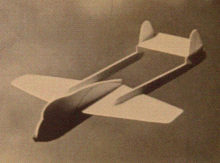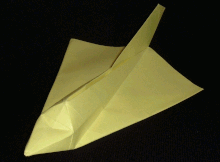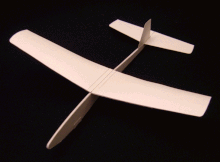Paper planes
A paper plane (also called a "paper swallow") is a flying object made from paper . It has no drive of its own and is usually started by throwing. However, it is also possible to launch it with a model rocket or a catapult . The occupation with paper airplanes is primarily a hobby today , but is sometimes also needed for the simulation of flight characteristics or for other experimental purposes.
Shapes of paper planes
A key feature of the paper plane is that its wings are as thin as possible. Profiles that are common in aircraft construction are not suitable for paper planes for physical reasons. The necessary stability must therefore be achieved in another way. According to the techniques of their manufacture, paper planes are divided into folding planes and paper planes .
Folding flyer
Folding flyers are usually made from one, sometimes several sheets of paper. The use of glue or damage to the paper is frowned upon, but adhesive tape or additional attachments such as paper clips do occur. When folding flyers are created solely by folding and do not contain any additional applications, they are also called origami flyers or oriplane.
Paper planes
Small airplanes made of paper are based in part on complex model aircraft . Here paper , cardboard or cardboard is only used as a material. Paper airplanes should be made from more than 75% paper.
history
The idea of making paper toys originated in China , where hang-gliding was a popular entertainment option 2000 years ago . However, the first mention of origami objects in China dates back to the 17th century.
In Europe, Leonardo da Vinci is considered the forefather of paper aviation. In his successor, many aviation pioneers experimented with paper airplanes. For example, models by Sir George Cayley , Alphonse Pénaud and Otto Lilienthal have survived . The first publication about paper airplanes is probably the book “Model Gliders” by EW Twining from 1909. The first German-language book with the title “Das kleine Buch vom Papierflugzeug”, author Gerhard Katz, was published in 1953.
In 1967 the "1st International Paper Airplane Competition", organized by Howard Luck Gossage for the magazine "Scientific American", took place. This was followed in 1985 by the "2nd Great International Paper Airplane Contest". Both competitions are inventories of the paper planes of that time. Despite numerous older sources, it is not certain exactly where many of the models and designs known today were created.
Flight behavior
The flight of a paper airplane is influenced by the following aspects:
material
- Paper type (s)
- Paper size (s)
- Attachment dimensions ( letter clips and staples , small coins, etc.)
- Glue etc.
layout
- Wing shape (geometry)
- Wing area (size)
- Sash position (V position)
- Center of gravity
- Stabilizers ( aircraft tail , winglets , etc.)
- Top shape
Release
- Breakpoint (where the plane is touched)
- Drop handle (how the plane is handled)
- Drop angle
- Discharge speed
- Discharge height
Surroundings
physics
The behavior of paper planes in the air can be predicted with a good approximation using school mathematics. Depending on the design, paper planes move ballistically and / or aerodynamically through the air. Pure ballistae are called throwers , all others are called gliders .
Thrower
A pure launcher moves through the air on a ballistic curve . A good approximation for its trajectory is the trajectory parabola , which it would follow exactly if there were no air resistance.
Glider
A glider can also be launched ballistically. However, after reaching the apex of the ballistic curve, its movement becomes aerodynamic flight. In aerodynamic flight, gliders behave similarly to real airplanes or birds. In contrast to these, paper planes are small and move at low speed, which is why their wings, like insects, are flown around in a laminar and not turbulent manner.
A special form of the glider is the so-called walker, also known as the walk along glider. With this type of paper airplane, the flight speed is selected so that it corresponds roughly to the walking speed of a person. If this person creates an updraft with his hands, a board or the like while running, which corresponds to the sinking speed of the glider, it flies in front of the person at a constant height. The walker can be controlled by changing the strength and direction of the updraft.
Competitions
Throwing paper planes is a tradition especially among children , but at the beginning of the 21st century paper flying also established itself as a sport . The sport, in which both the physical and the mental are important, is particularly popular with students .
Red Bull Paper Wings
Over the years, one particular competition has emerged, the Red Bull Paper Wings . Although there are no official world championships in paper flying , the Red Bull Paper Wings are also called World Championships. They have been taking place every 3 years early in May in Salzburg in Hangar 7 since 2006 .
Records
There are no official world championships for paper planes. Nevertheless, there are various records, which, however, were set under different competitive conditions with partly very different rules. These services are therefore difficult to compare with one another.
Guinness Book of Records
The following dates are listed in the Guinness Book of Records:
- Flight duration: 29.2 s - Takuo Toda (戸 田 拓 夫), Japan (December 19, 2010)
- Flight distance: 69.14 m - Joe Ayoob / John M. Collins, USA (February 26, 2012)
- Largest paper airplane: 18.21 m wingspan - team of students and employees of the TU Braunschweig (September 28, 2013). A paper airplane built in the USA with a length of 19.5 meters is not in the Guinness Book of Records because it does not have the minimum flight distance of 15 meters.
Red Bull Paper Wings
The Red Bull Paper Wings are the record holders:
- Flight time: 27.6 s - Ken Blackburn, USA (1998)
- Flight distance: 69.14 m - Joe Ayoob / John M. Collins, USA (February 26, 2012)
Origami flyer
- World record - flight time:
- 24.91 s - Takuo Toda (戸 田 拓 夫), Japan (March 28, 2009) A5 format
- National records - flight distance:
- Germany: 38.00 m - Alexander Schwarz, February 5, 2015, A4 / Letter format
- Japan: 37.92 m - Kishiura Takeshige (岸 浦 武 繁), March 28, 2009, A4 / Letter format
- Great Britain: 28.7 m - Robin Glynn, GB (September 19, 1997) A4 / Letter format
- National records - flight time:
- USA: 18.8 s - Ken Blackburn, February 17, 1994; A4 / Letter format
Other
- "Arturo's Desert Eagle" (German: "Wüstenadler") with a length of 14 m, a wingspan of 7 m and a mass of 360 kg - the enlarged cardboard model of a paper folding plane - is on March 21, 2012 from a height of 800 m 1.5 km and almost 160 km / h flown fast. The model was realized by the Pima Air & Space Museum together with the Arizona Aerospace Foundation based on a design by Arturo Valdenegro (12 years) from Arizona , USA.
Motorization
With a so-called “smart module” drive, which can be clamped to paper planes based on A4-size paper sheets, paper planes can be motorized and controlled remotely. The drive module consists of a thin rod (the fuselage) that carries an electrically driven pusher propeller and a rudder at the rear end and a receiver with an integrated battery and control electronics at the front . It is coupled via Bluetooth with an app for smartphones developed for the drive module . The app evaluates the position sensors of the smartphone and transmits the changes as control commands to the drive module.
literature
- Jerry Mander, George Dipple and Howard Gossage (German edited by Thomas von Randow ): Papierflieger - Das große Internationale Papierflieger-Buch , Heimeran Verlag , Munich 1979, ISBN 3 7765 0271 1 .
- Further international literature tips
Web links
- www.papierfliegerei.de
- Brief introduction to aviator physics
- Brief introduction to physics with a more academic approach
Individual evidence
- ↑ SPAZ-B flies in the gym
- ↑ Record in Braunschweig: The world's largest paper plane takes off Spiegel-online, September 28, 2013, accessed on October 4, 2013
- ↑ World's largest paper airplane does not fly; in: SPON, online
- ↑ http://greatpaperairplane.org/ Great Paper Air Plane Project - Pima Air & Space Museum , Arizona website , accessed April 22, 2012
- ↑ http://www.skyscanner.de/nachrichten/artikel/2012/04/012286-junge-aus-arizona-baut-grossten-papierflieger-der-welt.html ( page no longer available , search in web archives ) Info: The link was automatically marked as broken. Please check the link according to the instructions and then remove this notice. Boy from Arizona builds largest paper airplane in the world, scyscanner.de April 4, 2012, accessed April 22, 2012
- ↑ PowerUp 3.0: Smart paper airplane? You can bend! In: test . Stiftung Warentest , July 22, 2015, accessed on June 15, 2017 .












